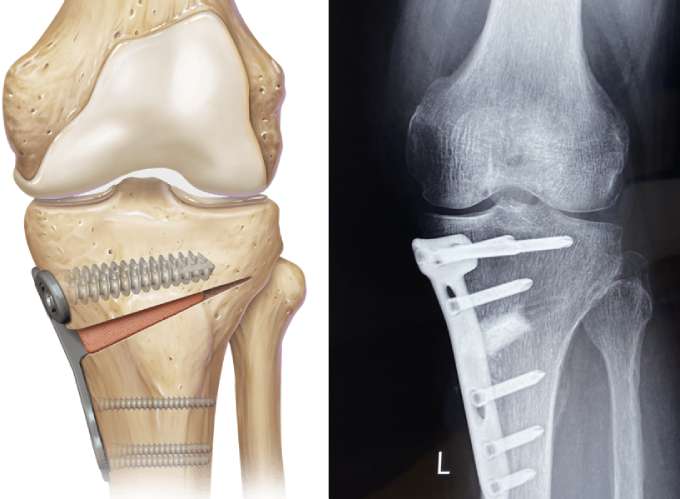What is a High Tibial Osteotomy?
An HTO surgery (high tibial osteotomy) is a procedure that involves cutting and reshaping the upper portion of the tibia (shinbone) just below the knee joint. It is commonly performed to correct mal-alignment of the lower limb with excess bowing (inward deviation) of the limb which increases the risk of development of degeneration and subsequent arthritis of the knee.
It may be done as a standalone procedure or sometimes combined with other procedures such as anterior cruciate ligament (ACL) reconstruction, meniscus repair or cartilage procedure. The basic purpose of all these surgeries is preservation of the native knee joint. If done at the right time, they can significantly reduce progression of degeneration of the knee and thus restore active lifestyle while also delaying need for knee replacement.
Why is it Done?
HTO may be recommended to:
- Relieve knee arthritis pain in younger, active patients
- Correct abnormal knee alignment causing excess load on one side
- In combination with meniscus repair or cartilage repair procedures to help protect the repaired tissue from overloading
- Delay or possibly avoid the need for knee replacement surgery

What patient can expect before surgery?
- We have detailed clinical examination to recognise the deformity of the lower limb and presence of additional pathologies if any.
- X-ray of the knee to evaluate the condition of the bone and the joint and ascertain the extent of the degeneration if any
- A standing scannogram which is a special X-ray done to evaluate the alignment of the lower limb. The surgery aims to correct any existing deformity that is contributing to the symptoms
- MRI of the knee maybe required in some patients whose complaints suggest additional injuries to the internal structures of the knee such as the meniscus and / or the cartilage.
- Preoperative physiotherapy assessment to assess the muscle strength and range of motion and to start “Pre-hab” exercises
- Anaesthesia checkup to recognise potential medical issues that can affect the peri-operative course
- Additional investigations like blood tests, chest Xray, electrocardiogram (ECG) or any other test as determined by the anaesthetist / physician as being essential for surgery
The Procedure
The surgery is usually performed under spinal anesthesia which may be augmented with an epidural pump.
- An incision is made over the upper tibia below the knee. The soft tissues are gently separated to expose the deformed part of the bone
- The tibia is carefully cut partly through its width (osteotomy).
- A wedge of bone is removed or the bone is reshaped to open a wedge-shaped space (closing wedge or opening wedge) which changes the morphology of the upper end of the tibia.
- The tibia is secured in its new position with a metal or PEEK plate and screws.
- The incision is closed with stitches or staples.
- The entire procedure is carried out with the help of a special X-ray machine which allows intra-operative evaluation of the limb alignment.
Benefits
- Realigns weight distribution to unload the arthritic side of the knee
- Can significantly reduce knee pain and improve function
- For some, it may delay or prevent future knee replacement
Recovery Process
- Limited weight bearing is advised for the initial 6 weeks.
- A patient doesn’t require bed rest following the surgery and all patients are started on knee range of motion exercises to prevent stiffness.
- Walker or crutches are used to ensure limited weight on the operated limb.
- Modern anaesthesia regimens allow for comprehensive post-operative pain control
- Physical therapy focuses on regaining range of motion and strength
- Most patients can resume normal activities within 4-6 months
Risks & Complications:
Potential risks include infection, bleeding, nerve injury, and non-union (failure of the bone to fully heal). HTO is most suitable for younger patients with isolated knee arthritis.
With proper patient selection, surgical technique, and rehabilitation, high tibial osteotomy can provide lasting knee pain relief and improved function for many active individuals.


